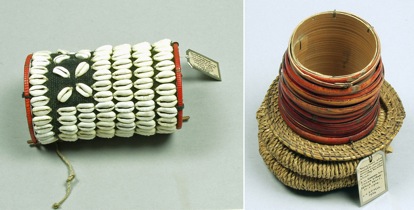Head-takers’ armlets
Lhota and Konyak Naga people, India
 Collected and presented by J.P. Mills; 1928.69.89 and .1735In Nagaland, body adornments were important markers of social identity. They were made from a variety of raw materials including hair, shell, metal, ivory, cane, seed, and bark.
Collected and presented by J.P. Mills; 1928.69.89 and .1735In Nagaland, body adornments were important markers of social identity. They were made from a variety of raw materials including hair, shell, metal, ivory, cane, seed, and bark.
Most ornaments were not freely available for anyone to wear, but were restricted to particular groups. The number and types of armlets and anklets worn depended on the right, either inherited or earned, to wear them. The number of feathers in a man's headdress or the pattern of his shell necklace, for example, might indicate his participation in expeditions, a mithan (ox) sacrifice, killing a tiger, or raiding an enemy village. These arm ornaments are both connected with taking heads.
The taking of enemy heads in Naga culture was connected to the concept of fertility. A head had to be taken every year to ensure good crops, health and prosperity for the village. It also represented a great personal success for any warrior who managed to take a head, and it entitled him to wear particular ornaments. A warrior of the Lhota Naga wore this cowrie shell armlet, the two crosses formed in the design indicating that he had taken a head. An Angami Naga warrior who had taken a head was entitled to wear a hornbill feather in his headdress and an ear ornament made of hair and beetle-wings. Among the Konyak Naga, necklaces with small pendant heads and hair ornaments with carved heads were worn, as well as armlets such as this made of coiled spathe, red cane, string and basketwork.
The taking of a head was not only important for the individual warrior, but for the whole village. This is reflected by the fact that tall the young men of the village could wear this armlet, not just the one who actually took the head. The ornament would be discarded at the start of a new year, and a new one made the next time a head was taken.
